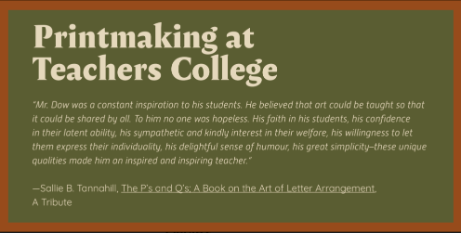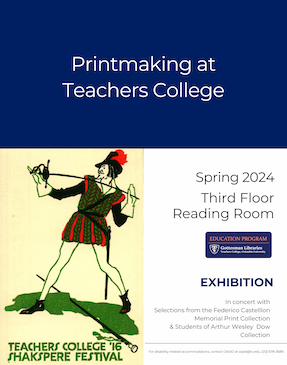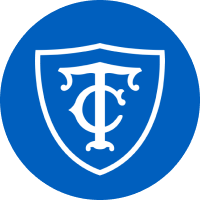New Exhibit: Printmaking at Teachers College
Third Floor Reading Room

Mr. Dow was a constant inspiration to his students. He believed that art could be taught so that it could be shared by all. To him no one was hopeless. His faith in his students, his confidence in their latent ability, his sympathetic and kindly interest in their welfare, his willingness to let them express their individuality, his delightful sense of humour, his great simplicity–these unique qualities made him an inspired and inspiring teacher.
– Sallie B. Tannahill, The P's and Q's; A Book on the Art of Letter Arrangement, A Tribute
The history and development of printmaking at Teachers College dates back to the influence of Professor Arthur Wesley Dow, author of Composition: A Series of Exercises in Art Structure for the Use of Students and Teachers (1899). Dow commented, “Printing is very simple, and in my opinion of special educational value. After observation of the craft in India in 1904, I was determined to introduce it into art courses—both for adults and children.”
Dow was especially interested in Japanese prints and color woodblock, and by 1912 work in all media was organized around his progressive exercises in composition. The curriculum over a two year sequence remained consistent for over a decade. Students first worked with Japanese brush and ink, on exercises in line and spacing of dark and light.Then they addressed value scales, patterns, and applications in landscape and lettering. In the second year, they began with wood block color printing and practical design work, followed by textile design, woodblock, book-illustration and illumination, and the decoration of covers. At the end of the two year sequence, they studied the special elements of color.
Printmaking also featured in the experimental and demonstration schools of Teachers College. At Horace Mann School in 1918, Albert Heckman, a student of Dow’s, introduced woodblock printing to third graders, enhancing their classes in early book making and illustration, though the blocks were carved by the teacher and older students. Heckman soon became an instructor and then an assistant professor at Teachers College. Throughout his teaching in the mid-1930s, he adopted Bauhaus influences—abstract, angular, and geometric design with little ornamentation in printmaking.
Under the Czech born Vojtech Preissig, classes at Teachers College printed with linoleum, zinc plates and wood blocks; posters and festival cards were emphasized in class projects made for College use. Linoleum, zinc plates and wood blocks were used to make posters and festival cards that promoted educational offerings and joyous events of the College, among them the Shakespeare Festival. After 1921, posters and color printing were integrated in lettering classes, for which Letters of Many Lands was produced and sold for the benefit of the Fine Arts Scholarship Club.
Under the modernist Charles Martin, who also studied art under Dow, classes were taught design, painting and print appreciation, blueprint reading, machine drawing, sheet metal drafting, and wood pattern making. In 1927 etching was added. Emphasizing technique, Professor Arthur Raymond Young began actual studio courses in graphics in 1934, with special short term courses in poster and publicity work. He taught printmaking for over forty years. Martin and Young’s focus on contemporary design is still seen in classes today, including Printmaking Processes, a basic course on silkscreen, Japanese woodblock, or lithography, taught by Professor Mahobe Ghods.
At New College (1932-1939) a progressive undergraduate college of Teachers College in North Carolina where Charles Martin also taught, students produced bold prints of industrial architecture and human problems, understandable topics during The Great Depression.
Among Charles Martin’s students was the illustrious artist and wordless novelist Lynd Ward (1926); Ward worked mainly with wood, though his other mediums included watercolor, oil, brush and ink, lithography, and mezzotint.
Linoleum blocks were continually used in TC alumna Sallie Tannahill's lettering classes, with a nod to her publication, P’s and Q’s : A Book on the Art of Letter Arrangement (1939), where she also describes the work of her friend and predecessor Mr. Preissig. Silkscreen was added in 1941-1942, while classes in lithography and etching continued the spirit of experimentation that guided the curriculum. Additions over the following decades included: Printmaking: Etching I: Intaglio, and Studio Work in Art and Education. Today the Printmaking Studio in Macy Hall “follows the pedagogy of artistic investigation and exploration of processes to expand one’s own creative expression. Students who come to the studio learn a variety of processes to develop their own practice, as well as how to teach the medium in their own classrooms.”
Victor d’Amico, founding Director of the Education Department at the Museum of Modern Art, studied at Teachers College from 1926-1930 and taught here for a decade until 1942. D’Amico believed in creative potential, experimentation, and individual expression–philosophy that shaped the modern Printmaking Studio at Teachers College. His widely acclaimed Children’s Art Carnival was an annual program that started at MoMA and traveled to Europe and India before moving to Harlem in1969; it has grown to include numerous mediums, including printmaking.
Teacher, draftsman, and printmaker Edwin Ziegfeld joined the art faculty of Teachers College shortly after the Second World and taught here for over thirty years until his retirement in 1970. He served as chairman of the department and editor of Art Education Today, the department's annual publication. His book, Art Today, “looked upon all of the visual environment as worthy of study and included it. It also emphasized the ‘contemporary’ rather than the ‘historic’ background.” He persuaded Spanish born Federico Castellon, then in his 30s, to teach a summer course in 1949, excusing him from the formality of a jacket and tie. Despite no formal degree, and joining right in with his students, Castellon, interested in Surrealism, became an Instructor of Fine Arts at Teachers College in the 1950s, and taught a variety of painting classes for more than a dozen years. He was a distinguished member of the Society of American Graphic Artists (SAGA) and recognized as an established artist and Guggenheim Fellow, widely exhibited in galleries and museums.
Printmaking at Teachers College offers insight into the work of our students and faculty, among them Albert Heckman and Federico Castellon who became notable artist teachers, much like Dow and successive generations of TC faculty. This display draws from the archival, research, curriculum, and children’s literature collections at the Gottesman Libraries to highlight printmaking at the College, as well as special materials that reflect study, research, and practice in the field. The historical art collections of Federico Castellon and Albert Heckman are featured in the Offit Gallery this Spring, while past exhibits by contemporary student printmakers include, “I Was Made in Shapes”, by Lindsey Frances Jones, Fall 2022, and “As I Am”, by Kendal O’Leary, Fall 2023.
After Dow’s death on December 13th, 1922, display cases inscribed to Dow were installed in Russell Hall to exhibit class work. With generous support from the Myers Foundation, the display case was refurbished to showcase historical treasures and enhance exhibits in the Offit Gallery. Select examples of archival and historical materials from the Gottesman Libraries aim to inform, inspire, and grow the artistic and educational process, as we carry on an important tradition.
Where: Third Floor Reading Room

Poster Image: Shakspere Festival Postcard, Art from the Dow Years, AG12, circa 1914-1918. Courtesy of Teachers College, Columbia University.
References:
Dow, Arthur W. (Arthur Wesley). Composition : A Series of Exercises Selected from a New System of Art Education. Third edition. New York: Baker & Taylor, 1900.
Faulkner, Ray, Edwin. Ziegfeld, and Gerald Hill. Art Today : An Introduction to the Fine and Functional Arts. Revised edition. New York: Henry Holt, 1949.
Gregory, Anne. (1987). Interview with Dr. Edwin Ziegfeld. Journal of Multi - Cultural and Cross - Cultural Research in Art Education, 5(1), 1-16.
Oral History Interview with Federico Castellon, 1971 April 7-14. Archives of American Art, Smithsonian Institution.
Printmaking Art Studio. Teachers College, Columbia University.
Rudge, William Edwin. Letters of Many Lands. New York: W.E. Rudge, 1921.
Preissig, Vojtech. “Producing the Festival.” Teachers College Record (1970) 17.2 (1916): 1–3.
Tannahill, Sallie Belle. P's And Q's: A Book On the Art of Letter Arrangement. Garden City, N.Y.: Doubleday, Page & company, 1927.
Wygant, Foster. A History of the Department of Fine and Industrial Arts of Teachers College, Columbia University. New York: Teachers College, Columbia University, 1959. Dissertation.
Printmaking at Teachers College is designed by Ashley Wang, Library Associate for Art and Design, and curated by Jennifer Govan, Library Director and Senior Librarian, with assistance from Conrad Lochner, Special and Digital Collections Librarian, and Victoria Santamorena, Processing Archivist.
And attend Digital Explorations in Leaving a Print, a studio workshop offered by Lucius Von Joo, Instructor of Communication, Media, and Learning Technologies Design, and Research Assistant at the Digital Futures Institute, on Friday, March 29th, 2-4pm.

